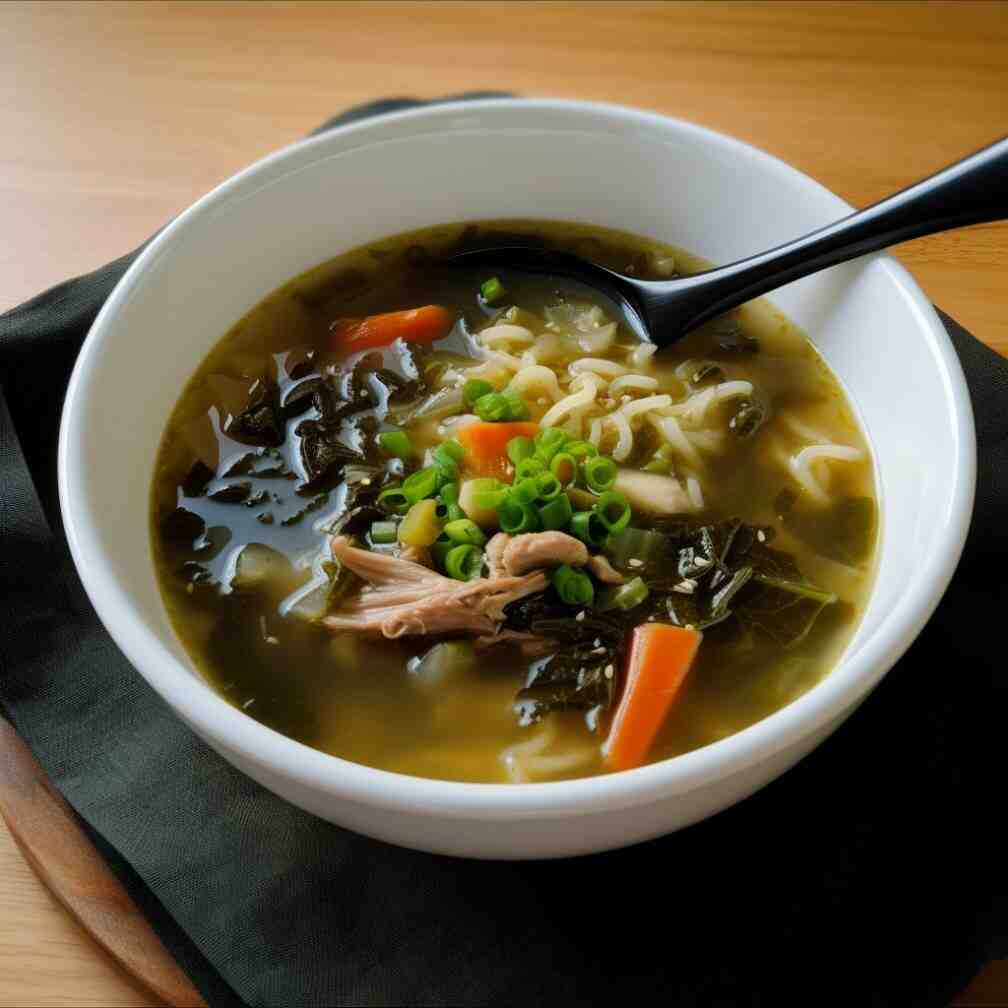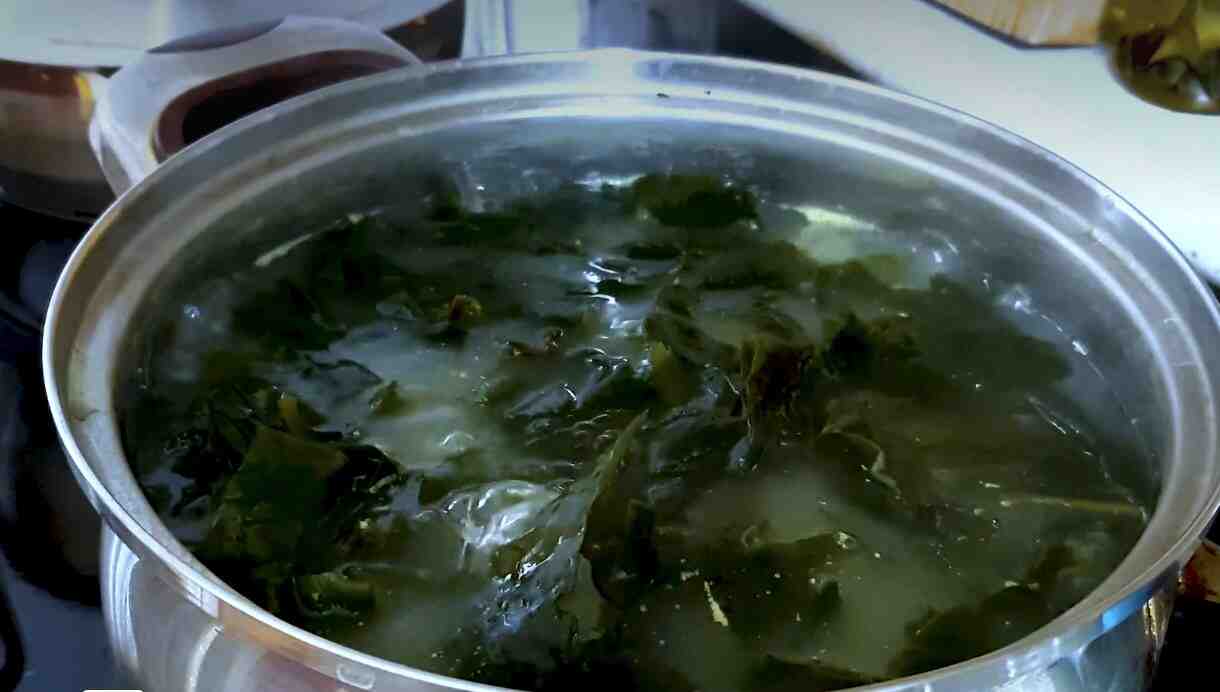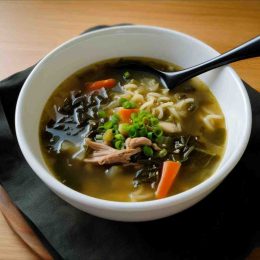Wakame soup, or miyeok guk, is a popular traditional Korean seaweed soup that is often served as a side dish or a main course. It is typically made with wakame seaweed which is a seaweed very rich in nutrients, including calcium, iodine, and iron. Aside from its nutritional benefits, wakame seaweed soup is known for its delicate and savory taste, as well as its pleasing texture. Its simple yet satisfying flavor makes it a beloved dish in Korean cuisine.

Prep: 10 mins Total: 20 mins Yields: 4
In Korean culture, wakame seaweed soup is often consumed by women after giving birth, as it is believed to help with lactation and postpartum recovery. It is also a staple food in Korean cuisine and is often served as a comforting meal on a cold day.
Why you’ll like it
- Korean wakame soup can be eaten at any time of the day, used it as a side dish alongside rice, kimchi, and grilled meat.
- Can be eaten for breakfast as it provides a bomb of energy and nourishment to help you kickstart your day.
- It’s a versatile dish that can be enjoyed any time of day, any season and alongside most side and main dishes.
- It’s easily converted into a vegetarian meal.
- Once you have seaweed in your pantry, the recipe is very easy to follow and is a great choice whether you’re on a healthy diet or on a budget.

What is Wakame?
Wakame is a species of brown algae or edible seaweed that is commonly used in Japanese, Korean, and other East Asian cuisines mainly for soups, salads and side dishes. It has a delicate flavor and a slightly slippery, chewy texture. It is often used in soups, salads, and side dishes, and is also used as a garnish for sushi and other Japanese dishes.
Wakame is known for being a good source of vitamins and minerals, including iodine, calcium, and magnesium. It is also low in calories and high in fiber, making it a nutritious addition to a healthy diet.
In addition to its culinary uses, wakame is also used in traditional medicine for its potential health benefits. Some studies suggest that wakame may have anti-inflammatory and anti-cancer properties, although more research is needed to fully understand its potential health benefits.
For Korean seaweed soup, use high-quality dried wakame seaweed ideally opting for the “miyeok” variety which is commonly used in Korean cuisine. Y When selecting dried wakame seaweed for miyeok guk, look for high-quality seaweed with a bright green color that is free from contaminants and has a delicate texture. It is also important to soak the dried wakame seaweed in water before using it in the soup to soften it and rehydrate it. This will help to ensure that the seaweed has a pleasant texture in the finished soup.
Korean seaweed wakame soup recipe
Korean wakame soup, or miyeok guk, is not difficult to prepare, and it is a dish that is commonly cooked in Korean households. The basic recipe only requires a few ingredients, and the preparation process is straightforward.
What is the Korean seaweed soup?
Wakame seaweed soup, or “miyeok guk” in Korean, has been consumed for centuries in Korea and is often associated with important life events such as birthdays, weddings, and the postpartum period. Korean mums love to cook this dish on their kid’s birthdays as a symbol of long life and good health and nowadays is still an essential part of Korean cuisine and culture.
The soup has a slightly sweet and savory taste and a soft texture from the tender wakame seaweed. It is made by simmering dried wakame seaweed, beef or anchovy broth, and various aromatics such as garlic, onion, and sesame oil. It is often served as a side dish with rice and other Korean dishes or as a comforting meal on its own. h.
New mums often eat this soup during the postpartum period mainly because it’s a warm hearty meal packed with lots of health nutrients. One of the many benefits of this soup includes helping to improve digestion during postpartum recovery while also supporting lactation. It’s really a superfood for mummies!
Miyeok guk is also associated with birthdays in Korean culture as it is believed that eating miyeok guk on your birthday will bring good luck, longevity, and health. So if you want to ensure a long and healthy life and you like this tradition – try eating this soup with seaweed the symbol of longevity.
Ingredients
- 1/2 ounce dried wakame seaweed, (0.5 ounces)
- 5 ounces beef chuck, sliced into bite-size pieces
- 1/4 teaspoon fine sea salt (or more to taste)
- black pepper to taste
- 1 tablespoon sesame oil
- 1 1/2 tablespoon soy sauce
- 1 teaspoon minced garlic
- 5 cups water
How to make the wakame soup?
- Cut the seaweed into 2cm lengths with scissors and soak in water for 10 minutes until it expands. Then rinse it with clean water a couple of times until the water is clear.
- Cut the beef into bite-size pieces adding black pepper and set aside.
- Drain the seaweed.
- In a pot start stir-frying beef, sesame oil, and minced garlic over medium heat.
- Then add seaweed and stir-fry together.
- When the stir fry becomes dry, add 100ml of water and the soy sauce and stir-fry for around 10 minutes.
- When the beef is cooked, pour all the remaining water and boil over high heat then reduce the heat to medium and simmer for around 5 minutes.
- Adjust the taste by adding salt if needed.
- Enjoy.

Wakame Soup (Korean Seaweed Soup)
Ingredients
- 1/2 ounces dried wakame seaweed
- 5 ounces beef chuck sliced into bite-size pieces
- 1/4 teaspoon fine sea salt or more to taste
- black pepper to taste
- 1 tablespoon sesame oil
- 1 1/2 tablespoon soy sauce
- 1 teaspoon minced garlic
- 5 cups water
Instructions
- Cut seaweed into 1 1/2 inch / 3 cm lengths with scissors and soak in water for 10 minutes until it expands. Then rinse it with clean water a couple of times until water is clear.
- Cut the beef into bite-size pieces adding black pepper and set aside.
- Drain the seaweed.
- In a pot start stir-frying beef, sesame oil, and minced garlic over medium heat.
- Then add seaweed and stir-fry together.
- When the stir fry becomes dry, add half of the water and the soy sauce and stir-fry for around 10 minutes.
- When the beef is cooked, pour all the remaining water and boil over high heat and then reduce the heat to medium and simmer for around 5 minutes.
- Adjust the taste by adding salt if needed.
- Enjoy.
